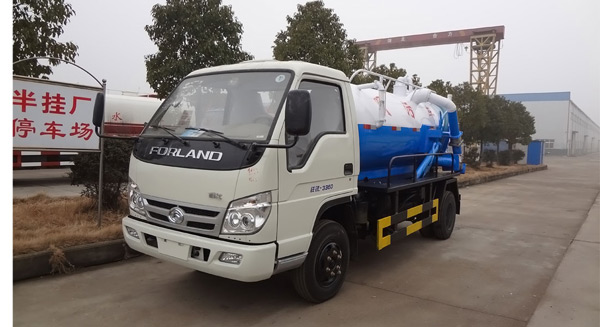In recent years, the aging of urban water networks in various parts of the country and the lack of planning and design at that time have caused frequent occurrence of sewage clogging after the heavy rain season. Local health management departments have also increased their attention to water network cleanup and sewage cleaning work. In this context, some new high-end vehicles such as high-pressure cleaning vehicles are emerging. The small sewage suction trucks that once dominated the suction and sewage industry gradually gave up their preferred position. How to improve the veteran, let the small sewage suction vehicle win a new place in the current strong competition background, I think it should gradually break through the following three.

The first is to break through the price blockade line and impress consumption with quality and low cost. By breaking through the limitations of previous production and manufacturing, and by making full use of the old production lines, we can save production costs and invest more funds in the research and development of small sewage suction trucks . After the design optimization, the three low performances of low manufacturing cost, low maintenance cost, and low use cost are guaranteed.
The second is to carry out various battles for the various problems and inconveniences of the old models of small sewage vehicles. Small sewage suction trucks only do their homework on the characteristics and humanization. They analyze the conclusions and conduct relevant design guidance from the perspective of customers and markets, so as to accurately locate their own product characteristics in the market. Grasp how to solve the old problems.
The third is to innovate multiple channels to broaden the sales perspective and depth. Through a new social media and online trading platform, conduct extensive customer data collection and product promotion. The elimination of the traditional sales channels of middlemen and dealers, the maximum price of which is limited by the manufacturers themselves, and the eradication of the strange phenomenon of low cost and high profits.
Breakthroughs in the development of small-scale sewage vehicles cannot be accomplished overnight, and it is not just in this article that we will guide the way forward. Specifically, how to once again increase the market share of small sewage trucks, and rekindle the wave of procurement of small sewage trucks, it still requires relevant designers and manufacturers to take a professional and focused attitude to take this thorny road.
Gasketed plate heat exchangers, also known as gasketed plate-and-frame heat exchangers (GPHEs), provide efficient heat transfer in compact equipment with a small footprint - much smaller and more efficient than shell-and-tube heat exchangers.
Plate heat exchangers are designed to optimize heat transfer, because the corrugated plates provide by far the greatest surface area through which the heat can be drawn from one gas or liquid to the other.
The units also have a flexible design and are easy to service and maintain.
Gasketed plate heat exchangers benefits:
Precision heat transfer - closer approach temperature, true counter current flow, 80-90% less hold-up volume
Low overall cost - low capital investment, reduced installation costs, limited maintenance and operating costs
Maximum reliability - less fouling, stress, wear and corrosion
Environmentally responsible - minimum energy consumption for maximum process effect, reduced cleaning
Easy to expand capacity - simply add or remove plates on the existing frame
The product range is extremely wide and is used in duties for heating, cooling, heat recovery, evaporation and condensation in industries ranging from HVAC, refrigeration, engine cooling, dairy and food to heavier processes like chemical processing, oil production and power generation.
Gasketed plate heat exchangers may be the industry standard for general heating and cooling duties, but the technology inside a GPHE is far from standard. All plate heat exchangers are NOT created equal, and we've seen the consequences of choosing heat exchangers purely based on cost. We understand cost is important, but in most circumstances the costs to repair or replace units, as well as the inefficiencies of undersized units, far outweigh the upfront capital cost savings.
Types of gasketed plate heat exchangers
Industrial - an extremely versatile range of heat exchangers for use in all types of industries
AlfaQ AHRI certified - similar to Industrial GPHEs, but are AHRI certified for HVAC applications
Industrial semi-welded - used in refrigeration when gaskets are not suitable for one of the media and when higher design pressures are needed
WideGap - used for applications involving fibrous liquids, highly viscous fluids, and fluids containing coarse particles
AlfaVap evaporators - tailor-made, rising film plate surface evaporator
AlfaCond condensers - a compact, plate surface vacuum condenser
Diabon - graphite Heat Exchanger used for tough corrosive media
Gasketed Plate Heat Exchanger,Epdm Gasket Plate Heat Exchanger,316 Gasket Plate Heat Exchanger,316 Stainless Steel Heat Exchanger
Liaoning LotusNine International Trade co.,ltd , https://www.lj-heatexchangers.com